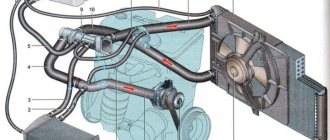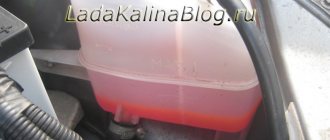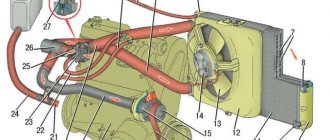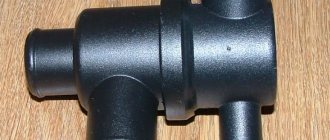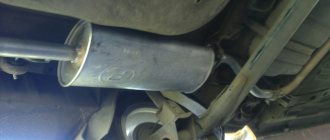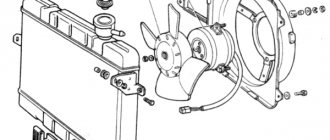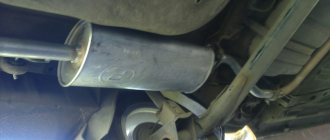In cars of domestic manufacturers, engine cooling occurs using a cooling system; in the VAZ-2114, this task is performed by antifreeze. Only with the right choice of antifreeze can you ensure efficient operation of the cooling system:
- Factory antifreeze fluid is worse; due to the smaller amount of additives, the thermal protection of the vehicle suffers significantly. Antifreeze was developed specifically to cool vehicle parts and components, so it is exceptionally useful.
- Factory fluid has one big drawback - it quickly spoils the pipes, which in turn leads to fluid leakage and radiator defects.
Having convinced himself of how important it is to use high-quality antifreeze, the driver of the VAZ-2114 begins to replace the old fluid with a new one. In this case, after a couple of weeks an antifreeze leak is detected, what’s the matter? The owner of the car did not take into account that along with the antifreeze, the pipes through which leaks occur must also be replaced.
Cooling system pipes VAZ 2114, 2115
The rubber pipes of the VAZ 2114 cooling system are examined in video and photos at the request of Boris Zverev...
Greetings, Lada VAZ car enthusiast on the RtiIVAZ website!
A YouTube channel subscriber came up with the idea to make a video about the rubber radiator pipes of the VAZ 2114 and the heater pipes of the VAZ 2114, just like his car. This video was filmed at the request of Boris Zverev, and the article was edited on the initiative of Albert Aukhadullin.
Let's start with the steam exhaust hose of the cooling system. This hose serves to remove steam from the radiator to the expansion tank. The length of this product is slightly more than one meter, the diameter of the internal hole is 8 mm.
This hose is installed on VAZ 2108, 2109, 21083, 2113, 2114 and VAZ 2115 models with injection and carburetor engines.
On models of the “ten” family, the same hose is installed as in the photo above, catalog number 2110-1303095.
Next we will consider the hoses installed to heat the throttle assembly.
These are inlet and outlet hoses for coolant. The diameter of the hose when measured with a school ruler is about 10 mm, and the length is 48 cm.
VAZ-2111 engine cooling system (with fuel injection system)
1 – expansion tank; 2 – plug; 3 – steam removal hose; 4 – hose from the expansion tank to the thermostat; 5 – coolant temperature sensor in the outlet pipe; 6 – throttle unit; 7 – radiator supply hose; 8 – radiator outlet hose; 9 – left radiator tank; 10 – right radiator tank; 11 – drain plug; 12 – radiator core; 13 – electric fan casing; 14 – electric fan impeller; 15 – electric motor; 16 – pump gear pulley; 17 – pump impeller; 18 – camshaft drive toothed belt; 19 – heater radiator outlet pipe; 20 – pump supply pipe; 21 – tap; 22 – heater radiator; 23 – coolant drain hose from the throttle pipe; 24 – coolant supply hose to the throttle pipe; 25 – coolant temperature indicator sensor; 26 – exhaust pipe; 27 – heater supply pipe; 28 – thermostat; 29 – coolant level sensor.
Radiator pipes VAZ 2114
Next comes the upper radiator inlet pipe, connecting the radiator to the engine block head.
This hose goes to injection engines. Its internal diameter is 32mm, see catalog number 21082-1303025.
The next one is the lower radiator outlet pipe, which connects the radiator to the engine cooling system thermostat.
Its catalog number is 21082 – 1303010, internal diameter is 32 mm.
“Angle” pipe for connecting the thermostat to the water pump (pump).
Catalog number – 2109-1303093-01. This pipe fits almost all front-wheel drive VAZ models.
The expansion tank pipe is popularly called the “filler pipe.”
It serves to connect the expansion tank to the thermostat. Through it, antifreeze enters the cooling system when the system is filled or topped up through the expansion barrel. See catalog number 21082-1303080 for its number.
Stove pipes VAZ 2114
The pipe that connects the heater to the block head is often called “big goose” in everyday life because of its resemblance to this bird.
The hose supplies coolant from the block head to the heater radiator. We look at the catalog number 2114 – 8101206.
These considered rubber hoses are reinforced, except for the throttle heating hoses and antifreeze steam exhaust hoses.
The goose curve hose is located under the hood of the car and serves to drain coolant from the heater radiator to the water pump.
Catalog number of the crooked goose 2114- 8101208, factory BRT.
The “short” pipe connects the thermostat to the engine block head.
Shorty catalog number 2108-1303082, BRT plant.
The “small” cabin pipe of the stove supplies coolant to the radiator of the stove, through the tap, from the “crooked goose”.
Its VAZ catalog number is 2114-8101200 from the BRT plant.
The cabin “large” outlet pipe is designed to drain coolant from the heater radiator through the “big goose” hose to the water pump.
Catalog number 2114-8101204 from the BRT plant.
Under the hood, the “big goose” supplies coolant to the heater radiator through a tap. And it takes the liquid to the pump from the radiator of the “goose curve” stove through the “large” cabin hose. For example, thanks to a set of rubber pipes, coolant circulates through the heater radiator.
The rubber pipe, the so-called injection “breather”, serves to connect the valve cover of the block head with the “snail” (2111) for supplying air to the engine.
The upper catalog number of the factory breather is 2111-1014058-10.
All connections presented in the video are located under the hood and in the interior of the VAZ 2114 car, related to the cooling system. In addition to the large breather pipes, small breather pipes and volutes, which serve for the passage of air.
The car also contains well-known gas supply hoses, brake hoses, a vacuum hose, as well as windshield washer fluid supply and others. They will also need to be viewed on video and described in the article.
All rubber hoses in a car need constant replacement, as they are exposed to aggressive liquids and gradually lose their properties. They lose their elasticity, become tanned, crack and sometimes break when used for a long time without replacement.
Therefore, it is recommended to periodically review their condition and replace them if any malfunction is detected.
This video ends the review; I hope that the video will be useful to someone both for information and when servicing their car.
Boris Zverev suggested in the comments the idea of equipping the Lada VAZ 2114 with a set of pipes, for which special thanks. I upload a video about the Renault Logan car on the YouTube channel, since it is my car. You, Boris, have subscribed and write comments about technology. Thanks again for this and respect.
Watch the video
Thank you for watching the video, subscribe to the channel, write comments and ask questions.
Numbers and analogues for pipes to radiator X22XE
#1 yuriua
. I looked through everything and still couldn’t find our original 34th diameter.
I bought some kind of Tazprom CRAP - a 35-diameter corner and not only did it start to swell in the spring, but it also began to LEAK through the cord thread.
I wanted to buy blue three-layer reinforced hoses, but the price of 17 USD for a 10 cm silicone pipe is daunting.
In general, does anyone have part numbers for analogue hoses of 34 diameters?
And where to buy them in Ukraine?
32 diameter is not suggested - I couldn’t tighten it. And I WILL NOT BUY soft Tazprom hoses ANYMORE. I have a large collar on the top tank.
Thanks for answers.
Look at the Gates catalog and look for ones that are suitable in shape and length.
Then look for who sells it there
That all original pipes are bought. Or will 32 work for everyone?
#5 sueng
GP 80 Plus (Product Type 3219) Robust hose for general industrial use, eg for conveying oil, hydraulic fluids, alcohols, aqueous solutions, acids, detergents and chemicals. Conducts static electricity for greater safety. • resistance to oil, abrasion, weather conditions and ozone; • minimum burst pressure of 110 kg/cm² (11 mPa) for sizes with an internal diameter up to 13 mm (1/2”) and 90 kg/cm² (9 mPa) for larger diameters; • Temperature range from -40°C to +95°C during continuous operation, temporarily up to +110°C.
Instructions for replacing the cooling system pipes of the VAZ-2114
In cars of domestic manufacturers, engine cooling occurs using a cooling system; in the VAZ-2114, this task is performed by antifreeze. Only with the right choice of antifreeze can you ensure efficient operation of the cooling system:
- Factory antifreeze fluid is worse; due to the smaller amount of additives, the thermal protection of the vehicle suffers significantly. Antifreeze was developed specifically to cool vehicle parts and components, so it is exceptionally useful.
- Factory fluid has one big drawback - it quickly spoils the pipes, which in turn leads to fluid leakage and radiator defects.
Having convinced himself of how important it is to use high-quality antifreeze, the driver of the VAZ-2114 begins to replace the old fluid with a new one. In this case, after a couple of weeks an antifreeze leak is detected, what’s the matter? The owner of the car did not take into account that along with the antifreeze, the pipes through which leaks occur must also be replaced.
Experience shows that old hoses are absolutely unusable; antifreeze corrodes them very quickly. Therefore, it’s time to learn how to replace pipes, and finally close the question of the correct operation of the cooling system. Service station specialists will tell you how to implement your plans.
How to correctly replace pipes in a VAZ-2114
The first question that experts hear from car enthusiasts is which pipes should be purchased for the VAZ-2114? Products made from silicone are considered the most durable and at the same time ideally compatible with the cooling mechanism of the VAZ-2114. The diagram below shows the location of the pipes we are interested in:
- The short ones are mounted on the couplings of the thermostat and the pump pumping water.
- Next comes the conductive hose.
- The pipe located in the lower part is responsible for removing antifreeze from the radiator unit.
Why the OS does not work
If you don’t know which cooling radiator is best to choose for the VAZ 2114, look at the existing one. Buy an analogue from the manufacturer, or purchase a device with the closest characteristics.
The fourteenth model is equipped with an aluminum radiator with two additional tanks. The radiator design includes:
- Radiator;
- Upper tank with pipes;
- Bottom tank with pipes.
Instructions for replacing the cooling system pipes of the VAZ-2114
Step-by-step replacement of cooling system pipes in a VAZ-2114 car looks like this:
- Remove the battery cable that comes out of the negative socket.
- Carefully drain the old coolant, but wait until the engine has cooled completely before doing so. Otherwise, there is a risk of getting burns from the coolant.
- Remove the following components: set aside the upholstery that provides sound insulation, the fan, the trim going to the windshield frame, the facing material.
- Now your goal is to get to the air collector; to do this, unscrew the brackets in the form of springs and the screws responsible for fixing them. A screwdriver is ideal for spring clips; for screws, you need a wrench.
- To loosen the clamps, remove the front housing, and then remove the old hoses from the fittings.
- All that remains is to install new silicone hoses in a specially designated place; it is preferable that the parts are manufactured abroad - they will last longer.
- Reinstall the other components by following the reverse order of this step-by-step instruction.
Replacement
Replacement
Now all that remains is to install a new set of pipes and complete this job. For this:
- Carry out installation by following the reverse sequence of disassembly and dismantling;
- Be sure to put new O-rings in place;
- Fill the cooling system with coolant;
- Start the engine and make sure there are no coolant leaks.
As you can see, replacing the cooling system pipes can easily be done with your own hands. This will require accuracy, consistency of your actions, as well as the use of new, high-quality parts to replace the old ones.
If you cannot or do not want to deal with such issues yourself, contact a good car service center, where they can quickly and efficiently bring your cooling system to normal condition.
Loading …
Subtleties of filling new antifreeze
Before you start filling in new coolant, you need to drain the old one, and also thoroughly clean the entire cooling system of contaminants. To do this, it is better to use a special cleaning agent that can be purchased at a car enthusiast store. Make sure that all taps and plugs of the VAZ-2114 are open. You can determine whether the system has been flushed or not based on the color of the antifreeze flowing out.
The plugs and tap are closed only when the product becomes transparent. If the manufacturer describes in the instructions the specifics of using the cleaning mass, follow these rules for effective cleaning. As for the level of antifreeze filling, some drivers prefer to fill to the limit mark, others deliberately do not top up, and later, after a successful test, add more fluid.
After the antifreeze has been replaced, all that remains is to close the expander and start the car engine. The motor should idle until the furnace fan starts running.
Repair or replace the tank?
Some drivers, having noticed that the expansion tank 2114 is leaking, try to repair the crack with glue or epoxy resin.
It should be noted right away that doing this is absolutely not worth it. After all, such repairs, as a rule, are short-lived, and with active use, even the most reliable adhesive seam can leak.
In addition, as already mentioned, the appearance of cracks in the tank is a sign of aging of the plastic caused by depolymerization - the volatilization of a number of fractions from the material that give it plasticity.
Reviews of silicone pipes for the VAZ-2114 cooling system
Drivers of the VAZ-2114, who replaced the usual factory rubber pipes with silicone ones, note the following advantages of the new components:
- Long service life, and all thanks to the increased wall thickness and dense reinforcement, consisting of several layers of material.
- Silicone hoses work successfully and efficiently, regardless of the temperature and weather conditions outside.
- When the silicone pipe is tightened, a force is felt, so overtightening and damaging the hose, like a rubber one, will not work in any case.
- The engine compartment can be painted any color you like.
Among the disadvantages of silicone pipes built into the cooling system of domestically produced VAZ-2114 cars, drivers note:
- high cost of parts, one set is approximately 1.5-2 times more expensive than rubber analogues;
- the manufacturer does not provide any warranty, so if you bought a defective product, it is impossible to replace it and you will again have to spend money on a new set of hoses.
In order not to pay extra, VAZ-2114 owners prefer to order silicone pipes in online stores, where they are found in 2 types:
- with reinforced thread;
- Along with silicone there is a rubber component.
Despite the possible negative nuances of silicone hoses, the owners of the VAZ-2114, who took the time to modernize their car and changed the pipes in the vehicle’s cooling system, note that the modification is worth the money - the engine is cooled like clockwork, no major comments are made.
As for the service life of new hoses, on average it is 2 years longer than that of rubber pipes, but only when it comes to reinforced silicone components.
The following video clearly shows how to change antifreeze and flush the cooling system of a VAZ-2114: https://www.youtube.com/watch?v=CGGDk3F1hNY.
The difference between a rubber hose and a silicone hose is explained in the video:
Which brake hoses should you choose?
In addition to the factory version, there are other analogue parts. Many people are engaged in the production of spare parts for the 4 and offer a set of flexible front hoses for 400 rubles . Part number – 1368 .
They are not much different from the handset, but due to the low price (the factory version costs about 500 rubles ) they are in demand among owners of “fours”. Strength is due to the reinforced layer and high-quality rubber covering the base of the tube. All parts intended for installation in the brake system undergo special quality control, so tubes from most manufacturers are equally good in terms of strength. Another option - reinforced brake hoses "AST" is not available in all stores, but is quite in demand due to the high strength of the product.
The price for the product is slightly higher than the factory version - about 650-700 rubles . The strength of the “AST” model is very high, so you can safely consider this analogue for purchase.
DIAGRAM AND DEVICE OF THE COOLING SYSTEM
The cooling system of the VAZ 2114 is liquid, with forced circulation. Antifreeze or antifreeze is poured into the system as a coolant. In the most extreme case, you can fill it with water, but you can’t drive it for a long time - in winter you can defrost the engine, and during the rest of the season, when the engine is used for a long time on water, the cooling jacket in the block and cylinder head is corroded, and rust accumulates in the radiator.
The VAZ 2114 engine cooling system (SOD) consists of the following elements:
- Radiator. It is the main cooling part in the system and performs the function of transferring heat to the liquid into the surrounding airspace;
- Water pump (pump). The pump creates forced movement of antifreeze in the system, thereby cooling the entire SOD, including the internal combustion engine (ICE). The pump rotates from the timing belt;
- Branch pipes (hoses). Antifreeze circulates through them;
- Thermostat. It regulates the passage of coolant through all pipes or only in a small circle and maintains the required operating temperature of the internal combustion engine;
- Electric fan. The fan is located on the plane of the radiator and, due to the air flow created, cools its surface when turned on. The electric motor turns on only when the temperature set by the sensor is reached (103°C);
- Expansion tank. Liquid is poured into the tank, and when the fan is activated, antifreeze flows into it through the return hose, thereby releasing excess pressure into the SOD;
- Expansion tank plugs. There are valves in the plug that relieve excess air pressure created in the system when antifreeze circulates.
The upper pipe is inflated
I changed the cap, checked the thermostat, poured it into the tank, and sucked it out as it cooled. It seems that the air in the cooling system should be removed on its own. What could be the problem? The pipe is hot, the temperature remains in the middle of the scale.
- Coolant fan does not turn on, Toyota Rav 4 – 9 answers
- Engine temperature sensor below 90 degrees in Toyota Rav4 2 – 4 answers
- Why does the Toyota Rav 4 eject antifreeze from the radiator cap? – 3 answers
- The coolant arrow does not show the temperature correctly - 1 answer
When it’s hot, that is, on a warm engine (CAREFULLY with a large piece of rag, open the lid, gradually bleeding air from the system), then put it on and it will inflate already in a warm engine. Can you imagine what happens when a car moves along the highway, at revs?
On Japanese ones, the air came out once or twice, if everything is in order, the air in the system simply has no place to come from.
It inflates for everyone, some more, some less. The temperature rises, and accordingly the pressure in the system also increases. Have you tried warming up the car to the opening temperature of the thermostat, when the lower pipe becomes hot?
As it cools, the air does not escape, but rather enters the expander, because the valve in the lid is bidirectional. In one case, it is triggered when the pressure in the system increases (during overheating). In another case, the valve allows air into the system when the coolant cools, so that a vacuum is not created in the system and the hoses are not flattened.
Thus, on a cold engine, the system must have atmospheric pressure, no more, no less. And if you have an air lock somewhere in the system, then it can remain there for a long time if it is not helped.
COOLING SYSTEM PROBLEMS
As a rule, due to malfunctions in the cooling system, the engine overheats, and this leads to engine failure. Any of the elements may be faulty.
- It may leak. Possible leakage through aluminum tubes and plastic tanks. Often the plastic outlet for the return hose of the expansion tank breaks off.
- It may clog, and for this reason the engine will heat up.
Pipes. Because of them, antifreeze leaks due to the fact that the pipe:
- Ragged.
- Old and lost elasticity.
Thermostat. Depending on how incorrectly the valve in the thermostat operates, the internal combustion engine can:
- Overheat (in this case, the antifreeze “throws out” through the expansion tank).
- Do not reach operating temperature. As a result, the car drives poorly, and in cold weather it is cold inside the car.
Water pump (three main problems):
- Noise and play in bearings. It is not worth driving with such a defect for a long time; the pump may jam or fall apart.
- Liquid is leaking through the inspection hole. It also signals the imminent “death” of the part.
- Broken impeller. With such a defect, the engine overheats very quickly.
- A faulty fan also leads to overheating of the internal combustion engine.
The clamps may be faulty or poorly tightened. It happens that thin hoses become clogged with debris (“return”, throttle valve heating).
Major failures of the expansion tank
The most common failures of the coolant reservoir are:
- cracks (appear over time as a result of depolymerization of the plastic from which the case is made);
- rubbing (occurs due to poor fixation of the tank, leading to its periodic contact with the body of the machine and abrasion of the plastic wall);
- destruction of the thread on the neck (can occur either from old age, as a result of depolymerization, or from careless handling);
- failure of the tank plug or its jamming (most often occurs on tanks that have been in use for a long time).
Thus, almost all breakdowns are in one way or another related to the destruction of plastic and the violation of the integrity of the tank or its plug.
Every motorist should remember that the most important element of the tank is its plug, which is responsible for regulating and relieving excess coolant pressure. As soon as it is noticed that it is faulty, you should immediately replace it, since traveling with a faulty cap can lead to swelling, deformation and even explosion of the tank.
REPAIR OR REPLACEMENT OF RADIATOR
Let us consider in detail the features of the work.
RINSE
Replacing the cooling radiator is required if the internal combustion engine heats up due to its clogging. But before changing it, you can try flushing the cooling system of the VAZ 2114 engine. Often flushing helps, and the engine stops heating up. We perform washing as follows:
- We park the car on a level surface;
- Unscrew the expansion tank cap;
- Drain the coolant from the radiator by unscrewing the bottom plug;
- We unscrew the water plug from the cylinder block (it is located between the internal combustion engine and the fan in the starter area) and drain the antifreeze from the block;
- We wrap the plugs and fill the system with plain clean water;
- Let the engine run and drain the water. If the water that comes out is dirty, repeat the flushing. We repeat the procedure several times until the draining water becomes clear;
- After flushing, fill in new coolant. It should be noted that the volume of the VAZ 2114 cooling system is 7.8 liters, and if all the antifreeze is not included in the system, most likely an air lock has formed in it. It is necessary to fill the container as much as possible to avoid overheating of the internal combustion engine.
It is often recommended to do the flushing on a cold engine to avoid being scalded by hot antifreeze. On the one hand, it seems to be true, but in cold weather all the dirt will settle on the walls of the SOD, and the washing efficiency will not be so great. And don’t wait every time for the water to cool down. You just need to drain the coolant carefully and work in thick, waterproof clothing and gloves. You also need to remember that the shelf life of antifreeze and antifreeze ranges from 2 to 5 years.
REPLACEMENT
Replacing the cooling radiator on a VAZ is very simple:
- Remove the expansion tank plug;
- Drain the antifreeze from the radiator and cylinder block. It is necessary to prepare a container for liquid in advance;
- We dismantle the air filter housing, it will interfere with removing the radiator;
- Disconnect the electric fan plug, unscrew the two bolts securing it and dismantle the unit;
- We loosen the clamps where it is more convenient and pull off the pipes;
- In the upper part of the radiator, remove the two bolts securing it to the body frame, tilt its body towards the engine and remove the part. Radiator removal is complete;
- We reassemble in the reverse order, then fill in antifreeze and start the engine.
REPAIR
If you wish, you can make minor repairs to the engine cooling yourself, but more often they repair it as a necessary measure:
- If you need to get to some destination;
- In the case when they did not expect a replacement and there is no money yet.
Plastic tanks can be sealed with epoxy resin or soldered; against leakage through the honeycombs, a special chemical composition is used, which is added to the antifreeze and clogs the leaking areas. But it is possible that such chemistry will complicate the passage of coolant throughout the system.
It’s easier not to be tricky with the radiator, but to replace it, especially since it is inexpensive, somewhere from 1,200 rubles.
Therefore, do-it-yourself repairs often become economically unjustified, and a lot of time is spent on useless “treatment.” True, there are more expensive copper radiators, but they are easier to repair - copper can be soldered.
Repairing the thermostat is hardly advisable; it is better to replace such a part immediately. Moreover, it costs about 350-500 rubles.
REPLACEMENT OF PIPE
Replacing the pipes of the VAZ 2114 cooling system is very simple - drain the coolant, loosen the clamp and replace it. In stores, pipes are often sold as a set, and it is also recommended to change them as a set.
Replacing pipes is easy (you can apply sealant to the joints)
Radiator repair
In some cases, the radiator can be repaired, so you don’t have to buy a new spare part.
Most often, liquid leaks at the junction of plastic and metal parts. If there is a small leak, you can pour a special liquid with a coolant mixture inside the radiator. Thanks to its special composition, this product will seal the defects that caused the leak. If the damage is serious, repairs will no longer save the situation; you will still have to replace the radiator.
To check the tightness of the radiator, you can conduct a simple experiment at home.
- Fill the bathroom with enough water to submerge the radiator.
- Close all pipe openings tightly.
- Lower the radiator under water about 30-50 centimeters. Apply a pressure of 0.2 MPa to it.
- Watch what happens. If bubbles appear, the system is not sealed and needs to be repaired or replaced.
VAZ 2114: cooling system and replacement of pipes
The VAZ-2114 car uses a hidden engine cooling circuit with an injector. It is highly complex and includes 28 elements. Traditionally, the assembly of the cooling system of this car is not of high quality. Therefore, throughout the entire period of operation, it requires constant monitoring, regular maintenance and repair. In this regard, many owners of this car are interested in the nuances associated with independent maintenance, repair and operation of the cooling system, among which the most common questions are:
- 1. How to properly replace the coolant mixture?
- 2. How to flush the cooling system?
- 3. How to remove air from the VAZ-2114 cooling system?
- 4. How to properly replace the cooling system pipes?
Find out the radiator pipes from VAZ 2108 to VAZ 2115
Radiator pipes VAZ 2108, 2109, 21099, 2113, 2114, 2115…
Hello dear reader of the RtiIvaz.ru blog. Let's find out today and talk to you about which radiator pipes are installed on Lada VAZ 2108, 2109, 21099, 2113, 2114, 2115 cars. Many car owners do not know what rubber radiator pipes for the cooling system are needed for and how they work. Here I’m trying to explain in simple language about RTI auto repair kits for vases, and also show on video what goes where. Forgive me if I'm wrong somewhere, since the rubber pipes of the cooling system are very difficult to understand. As a car enthusiast, I will try to explain to you about the radiator pipes for the cooling system, which ones fit where. Look at the photo and also at the video of the inlet, outlet, and bypass pipes. In general, you need to at least somehow understand the hoses on your Lada VAZ cars for a fulcrum under the hood.
Next, see a photo of the pipes of the Lada VAZ 2108, 2109, 21099, 2113 for cars with a carburetor engine:
For VAZ cars with carburetor engines
Number 1 is the “upper” pipe that “supplies” coolant from the engine to the radiator, the so-called “wave”, has the shape of a wave. And number 2 is the lower “angular” rubber pipe, which drains coolant from the radiator to the engine. At numbers 3 and 4, there is one “short” one, a bypass connects the engine head to the thermostat, and the second connects the thermostat to the water pump. Expansion barrel pipe for carburetor engines number 5. Design numbers:
You are a car enthusiast, you probably know that the upper supply hose supplies hot liquid from the engine for cooling in the radiator. And the lower outlet hose carries the already cooled liquid to the engine. This is the unusual role played by the rubber hoses of the cooling system. Next, see a photo of the pipes of the Lada VAZ 2108, 2109, 21099, 2113, 2114, 2115 for cars with an injection engine:
For VAZ cars with injection engines
Number 1 is the “upper” pipe “supplying” coolant from the engine to the radiator, “angular wave”, has the shape of an angular wave. And number 2 is the “lower” coolant discharge pipe. At number 3 is the “angle” bypass connected from the engine head to the thermostat and further to the water pump through the “short” coupling 4. At number 5 in the photo is the hose of the expansion barrel for injection engines. Design numbers:
Source
Briefly about the car
The VAZ-2114 hatchback is a fairly popular car that can still be found both on domestic roads and on the roads of the entire post-Soviet space. It was produced by AvtoVAZ OJSC from 2003 to 2013 and was one of the variants of the restyled series of the Samara-2 (VAZ-21093) family of cars.
During mass production, various engines with the same type of cooling systems were installed on it, which operate on the principle of internal heat exchange using a special cooling mixture of the “Tosol” type.
Cooling system diagram
Maintenance
Regular maintenance of the cooling system comes down to checking the level of the coolant mixture in the expansion tank and monitoring its color. It is recommended to check before each trip or, in extreme cases, regularly every 500 - 600 km.
The level of the coolant mixture in the tank must constantly exceed the minimum level by 2...3 cm. Checking the level and adding fluid must be carried out only on a cold engine. The mixture intended for topping up must be of the same type as the liquid poured into the system. Mixing different types is not recommended.
IMPORTANT! In the event of an emergency, you can add clean water to the liquid, but the cooling ability of the mixture deteriorates, and the presence of water contributes to corrosion on metal parts. In addition, in winter, the diluted mixture can freeze and damage both the radiator and the engine. Therefore, the coolant mixture diluted with water must be drained as soon as possible and, after repairing and flushing the system, it must be filled with the recommended coolant.
Thermostat repair
The thermostat sensor also serves to maintain the set temperature norm. It blocks the movement of the cooling mixture into the radiator until the engine heats up to the desired temperature of approximately 90 degrees. Liquid begins to flow through the thermostat when Celsius reaches 95 degrees. Using a thermostat, the engine takes minimal time to warm up. The thermostat is located between the engine and the cooling radiator.
Common problems:
- The valve is closed - the engine, when not warmed up, holds speed very poorly and may stall.
- With the valve open, you can drive during frosts, or turn on the heater to maximum mode, otherwise the engine will overheat.
When carrying out repair work on the thermostat, it is allowed to lightly tap the housing with a screwdriver to move the valve.
If it is necessary to completely disassemble the thermostat, it is important to tightly close the pipes to avoid antifreeze leakage, only then disassemble the thermostat. At the end of the repair, it is better to replace the antifreeze.
Available in stock: 50+
77.90 ₽ The price is valid only in the AutoPasker online store.
Delivery by courier, mail or pickup from AutoPasker stores. The minimum order amount is 500 rubles! More about delivery
Payment in cash upon receipt, VISA and MasterCard cards, bank transfer. More details about payment
Such a seemingly simple and unremarkable part of a car, like the expansion tank of a VAZ 2114, can actually cause quite a lot of trouble for the motorist if it breaks down. Today we will talk about the most common tank malfunctions, as well as how to fix them on your own.
Flushing the system and replacing the coolant
Repairs related to replacing the coolant on a VAZ-2114 car are carried out if:
- The color of the mixture in the expansion tank has changed. This usually happens after 20 - 40 thousand kilometers;
- repairs were carried out that required a complete drainage of the mixture.
In general, coolant replacement is carried out in the following order:
- 1. Completely drain the cooling solution. To do this, you need to open all the plugs and taps, and also remove the radiator and expansion tank caps. Drain the mixture only after the engine has cooled down (In a hot engine, the temperature of the solution can be more than 100 degrees Celsius).
- 2. Rinse the cooling system with distilled or clean water. Begin the washing procedure after all the old mixture has drained. It is recommended to flush the engine block and radiator with warm water. Otherwise, it is recommended to fill in cold water, warm up the engine, and then drain the water. The color of the water determines how dirty the system is and repeats the flushing process until the flowing water becomes clean. Only after this they begin to replace the mixture.
- 3. Pour a new cooling solution into the system, having previously closed all plugs and taps. Pour liquid into the tank in a thin stream until the maximum mark is reached. Air pockets are not allowed. Then the expansion tank and radiator caps are closed. In order to prevent the rubber pipes from drying out, they must be lubricated with silicone grease.
- 4. Start the engine and let it idle until the heater radiator fan turns on. After this, you can turn off the engine and, after cooling, check the fluid level in the tank. If the fluid level has not changed, then everything is normal and the work is completed. If the liquid level in the tank has decreased, you need to make sure by visual inspection that there are no leaks. If they are not there, then add fluid, start the engine again and repeat the test.
Replacing the coolant
To normalize the cooling system on a VAZ 2114, sometimes it is enough to replace the coolant. To determine when this needs to be done, you should know some nuances:
- The effective life of antifreeze is 2 years, and antifreeze is 5 years;
- Typically, replacing antifreeze is required after a mileage of 20-40 thousand kilometers, depending on operating conditions;
- A changed color of the composition indicates that it needs to be replaced.
antifreeze as a liquid , since it has a long service life and does not wear out the system so intensively. in favor of antifreeze is its affordable price.
Before adding new fluid, the system should be flushed. For this:
- Drain all existing coolant from the system;
- Screw the plugs tightly;
- Fill with high-quality distilled water to the maximum;
- Start the engine and bring it to operating temperature;
- The revolutions should be about 3 thousand. Avoid overheating the engine;
- After turning off the engine, leave the car for 7 minutes, after which the water is drained. If the system is heavily contaminated, the procedure must be repeated until completely clean distillate begins to pour out.
Replacing cooling system pipes
The cooling system of the VAZ-2114 car uses 4 rubber pipes:
- upper supply pipe - supplies cooled liquid from the radiator to the engine;
- lower outlet pipe - removes the heated liquid below from the engine to the radiator;
- two short pipes that connect the water pump and thermostat to the system.
If the pipes fail, they must be replaced. In this case, it is best to purchase silicone pipes.
To remove old and install new silicone (rubber) pipes, you need a set of wrenches, several screwdrivers and silicone lubricant.
Repairs associated with replacing pipes must be carried out in the following order:
- 1. Disconnect and remove the battery;
- 2. Drain all coolant mixture;
- 3. Remove the fan, soundproofing upholstery, trim and frame trim from the windshield;
- 4. Clear access to the air collector by removing its fastening elements;
- 5. Remove the front housing and release the clamps that hold the pipes;
- 6. Remove the pipes from the fittings and install new ones (silicone or rubber) in their place. Secure the new pipes with clamps. Before installation, it is recommended to lubricate the rubber pipes with silicone grease. It is also advisable to lubricate the clamp screws with silicone grease. Subsequently, this will allow you to easily unscrew them;
- 7. Install all the removed parts in their places, flush the system and fill it with new coolant mixture.
Necessary tools and spare parts
Replacing a faulty tube is possible with a minimum set of tools. Repairs to the “four” are often carried out by car owners, so having detailed replacement instructions won’t hurt. Carrying out work to replace a damaged tube is possible if you have the following tools:
- Keys for “10” and “15”;
- Wheelbrace wrench for wheel removal;
- Rags and containers for draining liquid.
The process of removing the old hose can be complicated by souring of the connection point. In this case, you should prepare WD-40 or a similar lubricant to treat the soured compounds. The VAZ 2114 brake hoses are quite durable, but if they are installed incorrectly, there is a risk of abrasion on the car body or wheel. When installing, you need to securely fasten the part in a special mount. In addition to replacement, during the diagnostic process of the system, you should check the condition of the discs, pads and the fluid itself.

